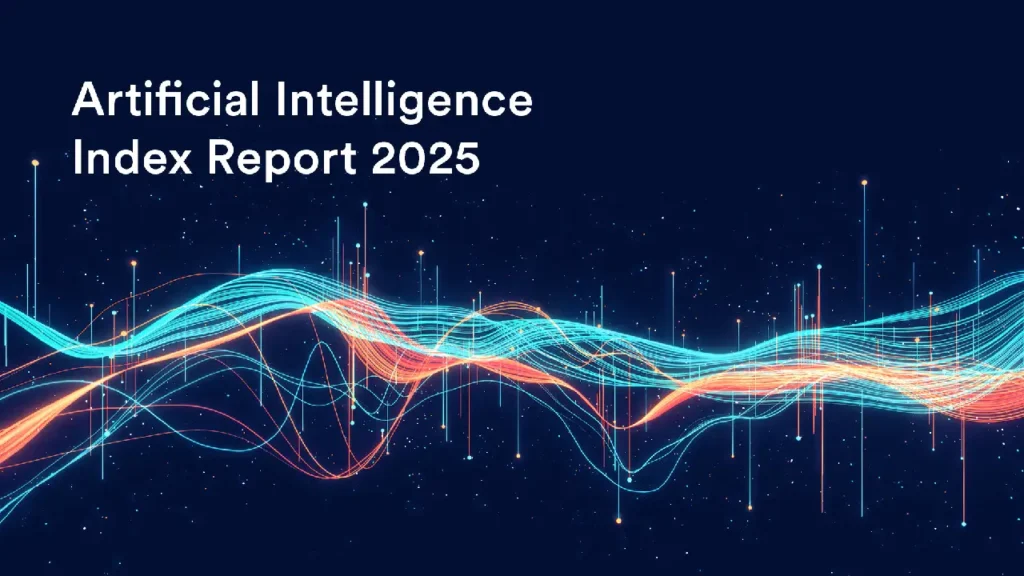For decades, Artificial Intelligence has been the promise of the next great revolution in the way humans work, create, and interact. But if 2023 and 2024 were for eye-popping breakthroughs and splashy demos, 2025 is turning out to be something deeper: the year AI went from being practical to being usable and more equitable. This is the dominant theme of Stanford’s AI Index Report 2025, the most-read and most-watched yearly evaluation of the state of AI globally.
Published by the Institute for Human-Centered Artificial Intelligence (HAI) at Stanford University, the report pulls together data on dozens of indicators—model performance, world investment, regulation, job trends, and so on. But this year’s results indicate unmistakably a change: AI is not only improving; it’s becoming demonstrably more efficient, more economical, and—most significant perhaps—more accessible to individuals, firms, and countries that were previously excluded from the AI competition.

Let us delve a bit deeper into the three major themes that characterized this year’s report.
Table of Contents
Smarter, Smaller, Faster: A New Era of AI Efficiency
One of the most astonishing advances chronicled in the index report is how rapidly AI models improve efficiency. Only two years ago, state-of-the-art performance on language tasks required massive models with hundreds of billions of parameters and huge energy consumption. In 2022, Google’s PaLM model, with 540 billion parameters, was required to reach approximately a 60% score on the Massive Multitask Language Understanding (MMLU) benchmark—a widely used test of AI model performance.
Skip forward to 2024 and Microsoft’s Phi-3-mini, which had only 3.8 billion parameters, scored the same. That’s a whopping 142x reduction in model size without sacrificing output quality. This type of efficiency is not solely a hardware tale—it is a result of innovation in data selection, training methods, and design architecture
The potential is staggering. Smaller models need less computation to train and execute. That translates to faster deployment, fewer emissions, and the possibility of bringing high-level AI into consumer-grade devices such as laptops and smartphones. As these models get lighter and cheaper, they pave the way for applications in education, healthcare, and logistics, generally with limited budgets and restrictions.

Efficiency also enhances fine-tuning and specialization. Businesses can now train specialized models at a fraction of the cost, making AI tools more pertinent and accurate across sectors, from legal contract review to agriculture forecasting.
AI Becomes Cheaper—Much Cheaper
In addition to performance improvements, the AI Index Report 2025 highlights a precipitous decline in inference cost—the act of asking an AI model a question and receiving an answer. Only two years ago, it cost approximately $20 per million tokens to execute GPT-3.5-level performance models, a model that stifled experimentation and broad usage. As of late 2024, that number has dropped to a mere 7 cents per million tokens, a 280-fold reduction.
This affordability shift is not a marginal improvement—it’s a game-changer.
Lower costs mean quicker iteration and experimentation for startups. For enterprises, it translates into the ability to scale AI-enabled features across products and departments without a prohibitive price tag. And for public institutions—schools, hospitals, local governments—it means AI-powered tools can now be realistically deployed in the service of the public good.
The price crash also speeds up the trend toward AI embedding in familiar services. Smarter auto-reply email apps, scheduling software that takes voice inputs, and spreadsheet programs that can understand natural language are all spreading not merely because the technology is improved but because it’s now economically sustainable at scale.
The Democratization of AI

Accessibility is the last—and perhaps most culturally significant—of Stanford’s 2025 findings. The AI index report is unambiguous: AI is no longer the exclusive purview of billion-dollar research institutions or top Silicon Valley startups. With a mix of open-source models, improved tooling, and hardware optimization, AI is being made for the world.
Open-weight models such as Meta’s LLaMA and Mistral, and more recent offerings from nations such as China’s DeepSeek and the UAE’s Falcon are reducing the barriers to creating formidable applications for academic researchers, solo developers, and even students. These models can be downloaded freely, modified, and retrained, enabling nations with limited AI infrastructure to start developing their custom solutions.
In a global environment where digital independence and data sovereignty are becoming increasingly politicized, this open-access campaign is more than merely a technological trend—it’s a transfer of power.
The Stanford report also identifies greater geographic diversification in AI contributions. Although the U.S. is still the dominant country for high-impact model development, China is closing the gap quickly, particularly through AI research papers and patent applications. Other countries—particularly India, Latin America, and parts of Africa—are increasingly active in applied AI domains, such as agriculture tech, fintech, and language localization.
The outcome is a more level, multipolar AI world—one that will most likely create more innovation, cultural diversity, and responsible innovation.

Not Just Improvement, But Pressure
The index report is cautiously optimistic overall, but does not whitewash the downsides of this wave of accessibility and deployment. Indeed, one of the slightly more sobering insights is that AI incidents—everything from system glitches to disinformation and abuse—are increasing too.
With an increasing number of humans capable of deploying AI, there is a pressing need for governance, standards, and education. The index report requires more robust ethical guidelines, more effective audit tools, and cross-border collaboration on topics such as bias, transparency, and AI security.
Simultaneously, the expanding availability of AI tools comes with a sort of moral obligation. When AI is cheap and productive enough to enhance public services, governments and businesses alike are presented with new responsibilities: not only to innovate, but to distribute those innovations in an equitable fashion and responsibly use them.
The Bigger Picture
Perhaps the most important message from Stanford’s 2025 AI Index Report is that AI’s most impactful transformation may not be technological—it may be social.

Efficiency and affordability are allowing AI to shift from a specialist tool to an optional layer of interaction in online life. Accessibility is making what was formerly an elite realm into a public utility. The actual champions in this latest phase will be those who don’t merely create better models but who deploy them in meaningful, ethical, and inclusive contexts.
The more integrated AI becomes into the fabric of everyday life, the more different the questions we’ll ask about it. No longer merely “What can AI do?” but “Who has access to it, and for what?”
Stanford’s AI index report doesn’t give us all the answers, but it makes one thing very clear: the era of AI is no longer arriving. It’s arrived—and it’s spreading to everyone.